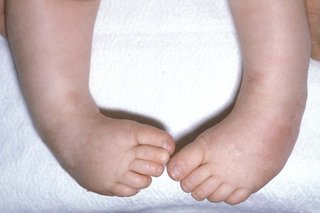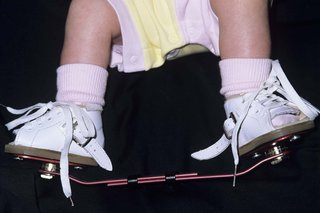Signs of clubfoot
If your baby has clubfoot their foot might:
- be bent and curved
- point inwards, up or down
- feel stiff and tight if you try to gently move it

Sometimes a baby has signs of clubfoot, but their feet move into a normal position over time without any treatment. This is called positional talipes.
How clubfoot is diagnosed
Clubfoot may be noticed during pregnancy, or it may be diagnosed after your baby is born.
After the birth, if a healthcare professional thinks your baby has clubfoot, they'll refer them to a foot clinic or a doctor who specialises in children's muscles and bones (a paediatric orthopaedic specialist).
Your appointment should happen within a few weeks of your baby's birth.
What happens at the appointment
The specialist may ask:
- to see and feel your baby's feet
- to look at and feel other areas of your baby's body such as their legs, hips and spine
- if anyone in your family has had clubfoot or other health conditions
They may also arrange an ultrasound scan or X-ray of your baby's hips, legs or feet.
How clubfoot is treated
Treatment usually involves the Ponseti method, which is done in 3 stages.
It starts with plaster casts to keep the foot in position, followed by surgery and wearing boots with bars.
Plaster casts
When your baby is a few weeks old, a plaster cast is put on their leg to hold the foot in a better position. The cast is replaced each week for around 6 weeks, improving the position each time.
Surgery
After about 6 weeks of wearing plaster casts, most babies need surgery to help the position of their foot. They'll wear a plaster cast for around 3 weeks after the operation.
Boots and bars
When the plaster cast is removed after surgery, your baby will need to wear boots and bars, sometimes called a brace.
The boots are soft and attached to a bar that helps to keep their feet in a healthy position. They'll wear these most of the time for around 3 months, and then usually only for naps and at night.
Your child may need to do this until they're 5 years old.

Your child will have appointments with the clubfoot clinic during this time. It's important to follow the treatment plan they discuss with you.
If your child does not wear their boots and bar for as long as they need to each day, their foot may not stay in the healthy position.
The clubfoot care team can answer any questions you have and offer support if you need it.
Causes of clubfoot
Usually it's not known why a baby has clubfoot.
Sometimes it happens in families when an altered gene is passed on to a child from their parents (inherited).
Sometimes clubfoot is linked to another health condition such as spina bifida or Edwards' syndrome (trisomy 18).
Help and support for clubfoot
You may find it helpful to get support from other parents and carers with a child who has clubfoot.
There is also a charity that offers information and support.
Steps Charity Worldwide
The charity offers help and support for anyone affected by childhood lower limb conditions, including clubfoot.
- Website: https://www.stepsworldwide.org
- Helpline: 01925 750271
Page last reviewed: 06 November 2025
Next review due: 06 November 2028